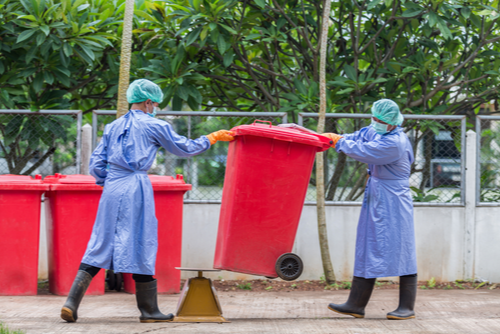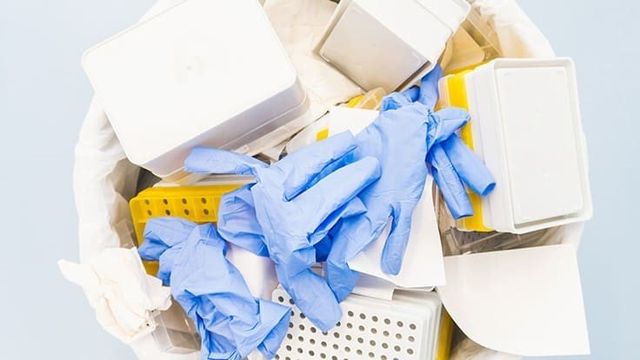Your Trusted Partner: Medical Waste Removal Services Tailored to Your Needs
Your Trusted Partner: Medical Waste Removal Services Tailored to Your Needs
Blog Article
Minimize Costs and Make Best Use Of Safety And Security: Effective Medical Garbage Disposal Strategies
Effective clinical garbage disposal methods are critical for medical care centers to lessen expenses and take full advantage of safety. With the growing problem for ecological sustainability and the boosting number of regulations bordering waste administration, it is necessary for health care organizations to embrace compliant and efficient techniques. By carrying out appropriate segregation and classification, effective packaging and labeling, secure transportation and handling, effective therapy and disposal methods, and conformity with regulative guidelines, medical care facilities can ensure the secure and accountable management of clinical waste. In this discussion, we will certainly explore each of these strategies thoroughly, providing understandings and useful pointers for health care specialists to enhance their garbage disposal processes.

Appropriate Partition and Classification
Correct segregation and categorization are important parts of reliable medical waste disposal techniques, making sure the safety and security of healthcare workers, the general public, and the environment - medical waste removal near me. medical waste disposal services with WasteX. By dividing various kinds of medical waste at the factor of generation, medical care centers can reduce the risk of cross-contamination and possible damage to individuals and ecosystems
One of the key consider correct segregation is the recognition and classification of medical waste. This includes categorizing waste right into different teams, such as contagious, hazardous, contaminated, or pharmaceutical waste. Each category calls for particular handling, storage space, and disposal techniques to stop any type of adverse results on human health and the atmosphere.
In addition, appropriate partition also consists of the use of color-coded labels and containers to plainly identify and separate the numerous kinds of clinical waste. This helps health care employees and waste management employees to easily acknowledge and take care of the waste appropriately. Red containers might be used for contagious waste, while yellow containers might be designated for dangerous waste.
Along with partition, proper categorization additionally involves the appropriate packaging and control of clinical waste. This ensures that waste is safely kept and transported without positioning any type of threats to people or the environment. Using puncture-resistant and watertight containers, along with effectively securing and labeling them, helps to stop any type of unexpected direct exposure or launch of unsafe materials.
Reliable Packaging and Labeling
Efficient packaging and labeling play a vital function in making sure the secure and reliable disposal of clinical waste. Correct product packaging is necessary to protect against leak, damage, or splilling during transportation and handling. It helps to minimize the risk of contamination and protects medical care employees, waste monitoring workers, and the atmosphere from prospective risks.
Medical waste should be packaged in watertight and strong containers that are resistant to puncture and damage. These containers need to be appropriately secured to prevent any kind of leakage. In addition, the product packaging ought to be able to hold up against the problems of transportation, including temperature variations and misuse.
Classifying is equally important as it gives vital info about the materials of the waste and any type of potential threats related to it. The labels must include the name of the medical care facility, the type of waste, and any type of special delivery guidelines. Standard and clear labeling makes sure that waste management employees can easily recognize and deal with the waste suitably.
Effective product packaging and labeling additionally aid in the correct segregation and classification of medical waste. Clear labeling permits easy recognition of different waste streams, such as contagious waste, sharps, or pharmaceutical waste. This aids in improving the disposal procedure and guaranteeing that the waste is dealt with or gotten rid of according to regulatory standards.
Safe Transport and Handling
Guaranteeing the secure transportation and handling of medical waste is of utmost relevance in order to avoid any type of possible health and environmental threats. Clinical waste, such as sharps, contaminated materials, and pharmaceutical waste, need to be properly packaged and dealt with to lessen the threat of exposure to damaging materials and virus.
Transferring clinical waste calls for conformity with rigorous regulations and guidelines set by ecological firms and neighborhood authorities. These regulations aim to safeguard the health and visit this website wellness of employees entailed in waste monitoring and protect against the launch of hazardous products right into the setting.
To ensure safe transportation, clinical waste must be positioned in watertight and puncture-resistant containers that are effectively sealed and identified. In addition, it is essential to use specialized lorries furnished with suitable safety attributes to carry medical Full Report waste. medical waste disposal services with WasteX.
Handling medical waste additionally requires appropriate training and adherence to safety and security protocols. Workers associated with the handling of clinical waste should use ideal personal protective devices (PPE) such as gloves, gowns, and masks to lessen the threat of direct exposure. They should also comply with stringent hygiene methods to stop the spread of infections and ensure the safe disposal of waste.
Effective Treatment and Disposal Techniques
Carrying out proper treatment and disposal methods is essential in handling medical waste efficiently and lessening prospective health and wellness and ecological dangers. Clinical waste, that includes sharps, contagious materials, chemicals, and pharmaceuticals, can position considerable risks if not dealt with and taken care of effectively. There are numerous therapy and disposal techniques offered that stick to regulatory guidelines and advertise secure methods.
One usual method is incineration, which involves burning the waste at high temperatures. Incineration is efficient in damaging virus and lowering the volume of waste, but it can release damaging contaminants into the air if not appropriately managed. Consequently, it is very important to make use of modern-day burners outfitted with exhaust control modern technologies.
One more technique is autoclaving, which utilizes steam and pressure to sterilize the waste. Autoclaving works in eliminating virus and minimizing the volume of waste, but it requires mindful surveillance and maintenance to guarantee proper performance. The decontaminated waste can after that be safely dealt with in a landfill.
Chemical therapy is one more option, which entails making use of disinfectants or other chemicals to counteract microorganisms. This method is generally utilized for liquid waste, such as research laboratory samplings. It is vital to make use of ideal chemicals and comply with appropriate procedures to ensure efficient treatment and protect against environmental contamination.

Conformity With Regulatory Standards
Abiding by governing guidelines is crucial in making sure proper compliance with clinical waste disposal methods. These standards are implemented to protect public health and wellness, prevent environmental contamination, and keep workplace security. Conformity with regulatory guidelines is critical for healthcare facilities, as non-compliance can cause fines, fines, and reputational damage.
Governing guidelines describe the appropriate handling, medical waste disposal services with WasteX storage space, transportation, and disposal of medical waste. They supply details instructions on packaging demands, labeling, and record-keeping. These standards likewise resolve the partition of different waste streams, such as sharps, infectious waste, and pharmaceutical waste. Health care facilities need to make certain that their waste monitoring practices align with these guidelines to reduce the danger of direct exposure to harmful products and protect against the spread of infections.
To maintain compliance, healthcare centers need to develop thorough waste monitoring programs that consist of team training, routine audits, and continuous tracking. It is vital to maintain updated with any type of updates or changes to regulatory standards, as techniques might develop in time. By staying educated and applying appropriate procedures, healthcare facilities can lower the capacity for regulative violations and shield the health and wellness of their staff, patients, and the bordering neighborhood.
Conclusion
In verdict, carrying out effective clinical garbage disposal techniques is essential for taking full advantage of and minimizing prices security. Correct partition and categorization, effective packaging and labeling, secure transportation and handling, and effective therapy and disposal methods are crucial actions to ensure conformity with regulative standards. medical waste removal near me. By adhering to these approaches, healthcare centers can protect the atmosphere and public health while likewise lowering monetary burdens connected with medical waste administration
By implementing appropriate partition and categorization, effective product packaging and labeling, safe transportation and handling, reliable therapy and disposal methods, and compliance with governing guidelines, health care centers can ensure the responsible and secure monitoring of clinical waste. Red containers may be made use of for transmittable waste, while yellow containers might be designated for harmful waste.
Clear and standardized labeling guarantees that waste administration employees can quickly identify and take care of the waste properly. (medical waste disposal services with WasteX)
Clear labeling enables for easy identification of different waste streams, such as infectious waste, sharps, or pharmaceutical waste. These guidelines also deal with the segregation of various waste streams, such as sharps, transmittable waste, and pharmaceutical waste.
Report this page